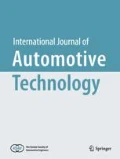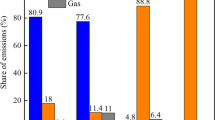Abstract
Particle number measurement is a new approach to determine emission, which may be more accurate at very low emission levels than when using gravimetric measurements. An experimental study was performed to investigate the effect of fuel properties on the performance, combustion process, regulated gaseous emissions and particle number emissions of a diesel engine with an uncatalyzed diesel particulate filter (DPF). The effect of the filter on the particle size distribution was reported. The DPF number-based filtration efficiency in terms of number efficiency and fractional efficiency for petroleum diesel fuel and two alternative fuels, BTL and GTL, were analyzed. For nearly all test modes, the filter had a higher number efficiency for diesel than for BTL and GTL. The DPF fractional efficiency showed it was highly dependent on fuel type and varied widely at each size range. For diesel, the filter fractional efficiency was sufficiently high and behaved as predicted by filtration theory. For BTL and GTL, the fractional performance of the filter decreased when unexpectedly low efficiencies within the nuclei mode were exhibited. This research will be helpful in understanding DPF number-based filtration performance for alternative fuels and will provide information for the development of particulate emission control technology.
Similar content being viewed by others
References
Azimov, U. B., Kim, K. S. and Jeong, D. S. (2011) Instantaneous 2-D visualization of spray combustion and flame luminosity of GTL and GTL-biodiesel fuel blends under quiescent ambient conditions. Int. J. Automotive Technology 12,1, 159–171.
Cho, Y. S., Kim, D. S. and Park, Y. J. (2008). Pressure drop and heat transfer of catalyzed diesel particulate filters due to changes in soot loading and flow rate. Int. J. Automotive Technology 9,4, 391–396.
Cheng, A., Dibble, R. and Buchholz, B. (2002). The effect of oxygenates on diesel engine particulate matter. SAE Paper No. 2002-01-1705.
Filippo, D. A. and Ciaravino, C. (2011). Particle number, size and mass emissions of different biodiesel blends versus ULSD from a small displacement automotive diesel engine. SAE Paper No. 2011-01-0633.
Huynh, T. C., Johnson, H. J., Yang, L. S., Bagley, T. S. and Warner, R. J. (2003). A one-dimensional computational model for studying the filtration and regeneration characteristics of a catalyzed wall-flow diesel particulate filter. SAE Paper No. 2003-01-0841.
Joshi, A., Chatterjee, S. and Walker, A. (2011). An evaluation of particle size distributions and particle number-based reductions from various PM emission control technologies. SAE Paper No. 2011-01-0600.
Johnson, T., Caldow, R., Pöcher, A., Mirme, A. and Kittelson, D. (2004). A new electrical mobility particle sizer spectrometer for engine exhaust particle measurements. SAE Paper No. 2004-01-1341.
Khalek, A. I., Kittelson, B. D. and Brear, F. (2000). Nanoparticle growth during dilution and cooling of diesel exhaust: Experimental investigation and theoretical assessment. SAE Paper No. 2000-01-0515.
Konstandopoulos, A. G., Kostoglou, M., Skaperdas, E., Papaioannou, E., Zarvalis, D. and Kladopoulou, E. (2000). Fundamental studies of diesel particulate filters: Transient loading, regeneration and aging. SAE Paper No. 2000-01-1016.
Kim, H., Lee, S., Kim, J., Cho, G., Sung, N. and Jeong, Y. (2005). Measurement of size distribution of diesel particles: Effect of instruments, dilution methods and measuring positions. Int. J. Automotive Technology 6,2, 119–124.
Liu, Z. G., Verdegan, M. B., Badeau, M. A. K. and Sonsalla, P. T. (2002). Measuring the fractional efficiency of diesel particulate filters. SAE Paper No. 2002-01-1007.
Liu, Z. G., Matthew, D. S. and Joseph, C. L. (2003). Diesel particulate filters: trends and implications of particle size distribution measurement. SAE Paper No. 2003-01-0046.
Lapuerta, M., Rodriguez-Fernandez, J. and Agudelo, J. R. (2007). Diesel particulate emissions from used cooking oil biodiesel. Bioresource Technol., 99, 731–740.
Lapuerta, M., Armas, O. and Rodriguez-Fernandez, J. (2008). Effect of biodiesel fuels on diesel engine emissions. Prog. Energy. Combust. Sci., 34, 198–223.
Lee, C. H., Oh, K. C., Lee, C. B., Kim, D. J., Jo, J. D. and Cho, T. D. (2007). Injection strategy of diesel fuel for an active regeneration DPF system. Int. J. Automotive Technology 8,1, 27–31.
Lee, J. W., Jeong, Y. I., Jung, M. W., Cha, K. O., Kwon, S. I., Kim, J. C. and Park, S. (2008). Experimental investigation and comparison of nanoparticle emission characteristics in light-duty vehicles for two different fuels. Int. J. Automotive Technology 9,4, 397–407.
Lee, S., Cho, Y., Song, M., Kim, H., Park, J. and Baik, D. (2012). Experimental study on the characteristics of nano-particle emissions from a heavy-duty diesel engine using a urea-SCR system. Int. J. Automotive Technology 13,3, 355–363.
Li, X., Huang, Z., Wang, J. and Wu, J. (2008). Characteristics of ultrafine particles emitted from a dimethyl ether (DME) engine. Chinese Science Bulletin 53,2, 304–312.
Myung, C., Kim, J., Kwon, S., Choi, K., Ko, A. and Park, S. (2011). Nano-particle emission characteristics of European and worldwide harmonized test cycles for heavy-duty diesel engines. Int. J. Automotive Technology 12,3, 331–377.
Myung, C. L. and Park, S. (2012). Exhaust nanoparticle emissions from internal combustion engines: A review. Int. J. Automotive Technology 13,1, 9–22.
Maricq, M. M., Chase, R. E., Podsiadlik, D. H. and Vogt, R. (1999). Vehicle exhaust particle size distributions: A comparison of tailpipe and dilution tunnel measurements. SAE Paper No. 1999-01-1461.
Pushkar, T., Achim, H., Jeanni, W., Naveen, K. and Kranthi, C. (2010). Measurement and prediction of filtration efficiency evolution of soot loaded diesel particulate filters. Chem. Eng. Sci., 65, 4751–4760.
Schneider, J., Hock, N., Weimer, S., Borrmann, S., Kirchner, U., Vogt, R. and Scheer, V. (2005). Nucleation particles in diesel exhaust: Composition inferred from in situ mass spectrometric analysis. Environ. Sci. Tech., 39, 6153–6161.
Tan, P., Lou, D. and Hu, Z. (2010). Nucleation mode particle emissions from a diesel engine with biodiesel and petroleum diesel fuels. SAE Paper No. 2010-01-0787.
Vaaraslahti, K., Virtanen, A., Ristimäki, J. and Keskinen, J. (2004). Nucleation mode formation in heavy duty diesel exhaust with and without a particulate filter. Environ. Sci. Tech., 38, 4884–4890.
Vaaraslahti, K., Virtanen, A., Ristimäki, J. and Keskinen, J. (2004). Effect of after-treatment systems on size distribution of heavy duty diesel exhaust aerosol. SAE Paper No. 2004-01-1980.
Yao, D., Lou, D., Hu, Z. and Tan, P. (2011). Experimental investigation on particle number and size distribution of a common rail diesel engine fueling with alternative blended diesel fuels. SAE Paper No. 2011-01-0620.
Author information
Authors and Affiliations
Corresponding author
Rights and permissions
About this article
Cite this article
Wang, D., Liu, Z.C., Tian, J. et al. Investigation of particle emission characteristics from a diesel engine with a diesel particulate filter for alternative fuels. Int.J Automot. Technol. 13, 1023–1032 (2012). https://doi.org/10.1007/s12239-012-0105-5
Received:
Revised:
Accepted:
Published:
Issue Date:
DOI: https://doi.org/10.1007/s12239-012-0105-5




